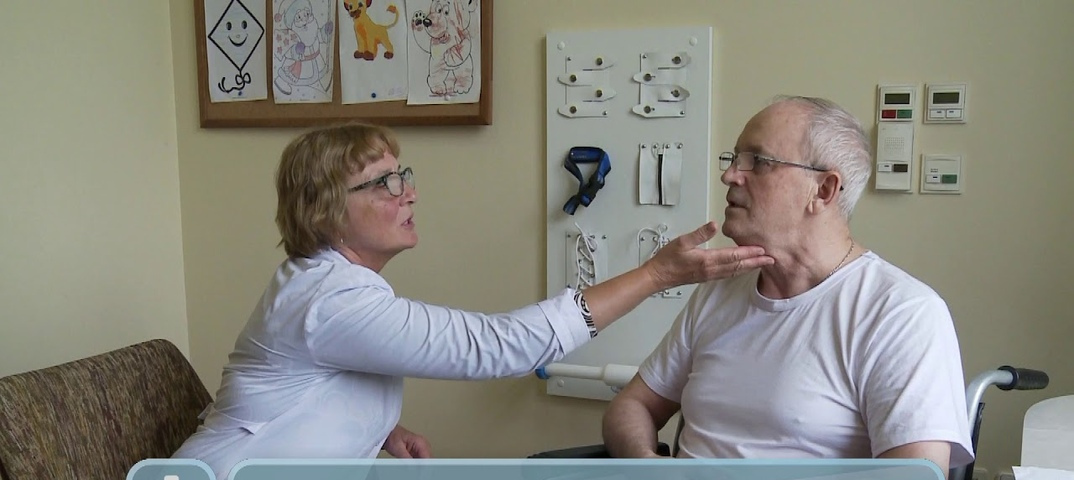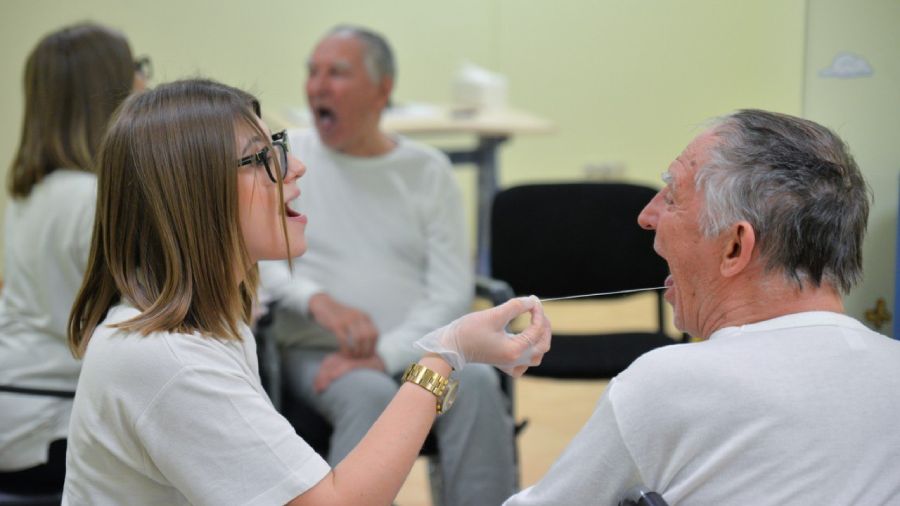Anarthria and Dysarthria Overview. How these conditions affect speech
Medically reviewed by Smita Patel, DO
Dysarthria is a speech disorder that is caused by problems controlling the muscles used for speech. Anarthria is the most severe form of dysarthria. It results in the inability to produce clear, articulate speech.1
This article will go over what dysarthria and anarthria are. You will learn about the causes, symptoms, diagnosis, and treatment of these speech disorders.
Dysarthria and Anarthria Causes
Dysarthria (also known as dysarthosis) and the more severe form, anarthria, are caused by brain damage. Conditions that are present at birth, such as cerebral palsy or muscular dystrophy, can also cause dysarthria and anarthria.

When dysarthria is present from birth, this means that a person never developed the ability to produce understandable speech. Dysarthria and anarthria may also occur as a result of neurological conditions such as multiple sclerosis2 and stroke, causing a decline in speaking abilities after a person already had attained the ability to speak clearly.
The following conditions can all cause dysarthria or anarthria:3
- Stroke
- Traumatic brain injury
- Brain tumor
- Parkinson’s disease
- Amyotrophic lateral sclerosis (ALS), or Lou Gehrig’s disease
- Huntington’s disease
- Multiple sclerosis
- Myasthenia gravis
- Bell’s palsy
- Wilson’s disease
- Guillain-Barre syndrome
- Lyme disease
Certain medications, such as narcotics or sedatives, can also cause dysarthria. Typically, this type of dysarthria resolves after the medication wears off or is stopped.
APHASIA. DYSARTHRIA. SET №1:TONGUE EXERCISES
For additional information about the rehabilitation of the patients with Aphasia, Dysarthria you can watch a video demonstrating exercises and rehabilitation recommendations.
Symptoms of Dysarthria and Anarthria
If you have dysarthria, you are likely to have speech characterized by one or more of the following characteristics:1
- Slowed rate of speech
- Mumbling quality to speech that is difficult to understand
- Limited movement of the tongue, lip, and jaw
- Abnormal vocal pitch
- Abnormal rhythm to speech
- Hoarseness or breathiness to speech
- Nasal or stuffy-sounding speech
- Inability to speak loudly
APHASIA. DYSARTHRIA. SET №2:LIP EXERCISES
Types of Dysarthria and Anarthria
All types of dysarthria are characterized by slurring of speech. If you have dysarthria, when you attempt to speak, you may notice that your vowels sound distorted.
Dysarthria may be mild, moderate, or severe. The level of dysarthria depends on the degree of damage to the neurological system.
If you or a loved one are affected by dysarthria, you might notice one or more of the common speech patterns characteristic of dysarthria. These patterns include:3
- Spastic dysarthria: As the name suggests, this speech pattern is characterized by bursts of sounds as you try to speak. This type of dysarthria is caused by damage to the pyramidal tract, which is a pathway in the brain that controls motor function in the face and body.
- Hyperkinetic dysarthria: This is a pattern of speech caused by lesions of the basal ganglia, which is a region in the brainstem.
- Hypokinetic dysarthria: This is a pattern of speech associated with Parkinson’s disease.
- Ataxic dysarthria: This is a haphazard speech pattern caused by damage to the cerebellum, which controls balance and coordination.
- Flaccid dysarthria: This is a ‘weak’ speech pattern caused by damage to the cranial nerves, which are the nerves that directly control the mouth and throat muscles.
- Mixed dysarthria: This is a combination of dysarthria types caused by damage to several regions of the nervous system, such as the upper or lower motor neurons.
APHASIA. DYSARTHRIA. SET №3: CHEEK EXERCISES
How Dysarthria and Anarthria Are Diagnosed
Dysarthria and anarthria are diagnosed by a medical professional. Your medical team will listen carefully to your speech and your medical history, and you should expect a thorough physical examination.
One or more of the following diagnostic tests may need to be performed to determine the cause of your dysarthria:1
- MRI
- CT scan
- Brain and nerve studies
- Blood tests
- Urine test
- Lumbar puncture
- Brain biopsy
APHASIA. DYSARTHRIA. SET №4: JAW AND PALATE EXERCISES
Treatment for Dysarthria and Anarthria
Dysarthria and anarthria can be treated. A speech-language pathologist can identify the best course of treatment after your medical evaluation. A variety of techniques may be used during treatment. If your muscles are weak or stiff, you might need exercises tailored to your specific problem. Typically, treatment includes incorporating relaxation techniques, lingual and mandibular exercises; isometrics, and phonetic stimulation.3
APHASIA. DYSARTHRIA. SET №5: RESPIRATORY-VERBAL, ARTICULATORY EXERCISES
Difference Between Aphasia and Dysarthria
Anarthria and dysarthria are not caused by problems with language comprehension or problems thinking or finding the right words. Aphasia, in contrast, is a speech problem that is caused by trouble producing and/or understanding speech due to problems with one or more areas of the brain that are responsible for language.

People who experience anarthria have the ability to understand words but are unable to produce understandable speech. Dysarthria partially affects the muscles used for speech production; anarthria is due to a more significant loss of muscular control of the speech muscles. The muscles involved in speech include the muscles of the lips, tongue, mouth, vocal folds, and diaphragm.
Unlike in people with aphasia, those with dysarthria retain the ability to read and write even though they can’t speak.
What is Aphasia?
By Jose Vega MD, PhD
Jose Vega MD, PhD, is a board-certified neurologist and published researcher specializing in stroke.
Summary
Living with dysarthria or anarthria can be frustrating because these speech disorders make it difficult to communicate. Dysarthria can partially or completely improve on its own, depending on the cause. If your dysarthria is not expected to improve on its own, therapy and exercises will help optimize your ability to speak and communicate clearly.
FREQUENTLY ASKED QUESTIONS
1. What type of dysarthria is most common?
Mixed dysarthria is the most common type. It’s caused by damage to several regions of the nervous system, but particularly the upper or lower motor neurons.4
2. Is dysarthria the same as dysphagia?
Dysphagia is trouble swallowing. A lot of conditions that lead to dysarthria can also cause dysphagia. For example, people who have had a stroke or a person with multiple sclerosis (MS) may develop dysphagia, dysarthria, or both.5

CHECK OUT THE DEMO VERSION OF OUR EXERCISES FOR THE PATIENS WITH APHASIA, DYSARTHRIS ON YOUTUBE.
Our website presents the following sets of exercises for rehabilitation of the patients with Aphasia, Dysarthria:
-
APHASIA. DYSARTHRIA. SET №1:TONGUE EXERCISES
-
APHASIA. DYSARTHRIA. SET №2:LIP EXERCISES
-
APHASIA. DYSARTHRIA. SET №3: CHEEK EXERCISES
-
APHASIA. DYSARTHRIA. SET №4: JAW AND PALATE EXERCISES
-
APHASIA. DYSARTHRIA. SET №5: RESPIRATORY-VERBAL, ARTICULATORY EXERCISES
Sources
https://www.verywellhealth.com/what-is-anarthria-3146173
- Cleveland Clinic. Dysarthria.
- Wilkins A. Cerebellar dysfunction in multiple sclerosis. Front Neurol. 2017;8:312. doi:10.3389/fneur.2017.00312
- American Speech-Language-Hearing Association. Dysarthria In Adults.
- Kirshner, H. Motor Speech Disorders: Dysarthria and Apraxia of Speech.
- Wang BJ, Carter FL, Altman KW. Relationship between Dysarthria and Oral-Oropharyngeal Dysphagia: The present evidence. Ear, Nose & Throat Journal. Published online October 12, 2020:014556132095164. doi:10.1177/0145561320951647











